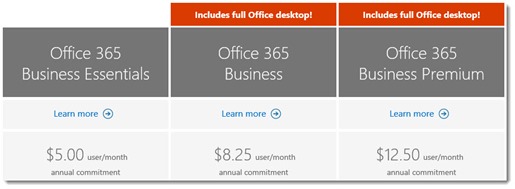Small businesses can now choose new, cheaper plans for Office 365. Making a choice is not a well-organized experience at the moment, though, because a long list of plans includes all the previous overlapping and confusing versions.
There are three new plans. All of them include online storage space in OneDrive for Business and use of the online versions of Office. These are the important differences for small businesses:
Office 365 Business Essentials ($5 user/month): Exchange mailbox
Office 365 Business ($8.25 user/month): License for Office programs (Word / Excel / Outlook / Powerpoint / OneNote / Publisher)
Office 365 Business Premium ($12.50 user/month): License for Office programs and Exchange mailbox
The prices for the Office license (“Business”) and the combined Office license and Exchange mailbox (“Business Premium”) are considerably cheaper than the previous options. It’s hard to compare because the features are never identical but these plans are roughly 25% less than the choices I’ve made in the last few years for my clients.
When you look at this page, it appears to be simple to choose an Office 365 plan. It still seems manageable even after you notice the little arrow to display the Enterprise plans as well.
If you’re not an Office 365 administrator, you won’t see the real list of plans, displayed in the Office 365 administrator portal under “Purchase services.” The list changes depending on your current subscriptions, but most businesses see an unsorted list of more than forty different Office 365 plans, ranging from “Office 365 Enterprise K1” for kiosk users, up to “Microsoft Dynamics CRM Online Enterprise” at $200/month per user, with stops in between for Visio, Project, Sharepoint, Lync, Yammer, and many – too many – plans slicing and dicing Office and Exchange.
At one time it was impossible to combine Office 365 licenses from different tiers of service. Apparently there were literally different servers holding the data for enterprise plans and small business plans. Most of that has been resolved and now it’s possible to mix and match plans, buying Business Premium licenses that will co-exist with Enterprise E3 licenses, say.
Even that is not straightforward, though. Many of my clients have licenses for Office ProPlus at $12/month. It appears to be identical to the license for Office 365 Business, which also authorizes installation of the Office programs on up to five computers for only $8.25/month. Not so fast! It’s two different versions of the Office suite. Office ProPlus includes Access, Office 365 Business does not. Switching from one plan to another is simple in the Office 365 portal – but that user has to install Office 365 Business, then uninstall Office ProPlus. Here are the rules of that game. It’s an ugly and unintuitive requirement.
Also worth noting: these plans are completely unrelated to the consumer plans “Office 365 Personal” and “Office 365 Home”, because Microsoft hates you and wants you to be confused.
Don’t get caught up in the details. Prices are going down and features are being added for enterprise-quality services. Make sure you talk to a Microsoft partner when you want to sign up for Office 365!


